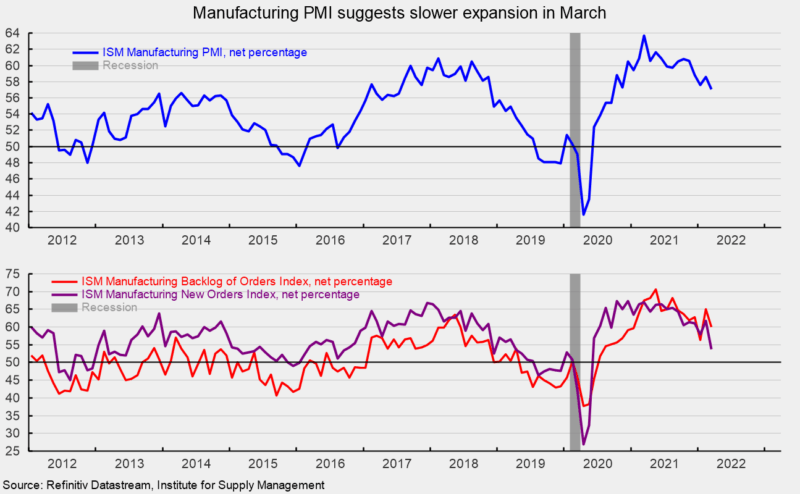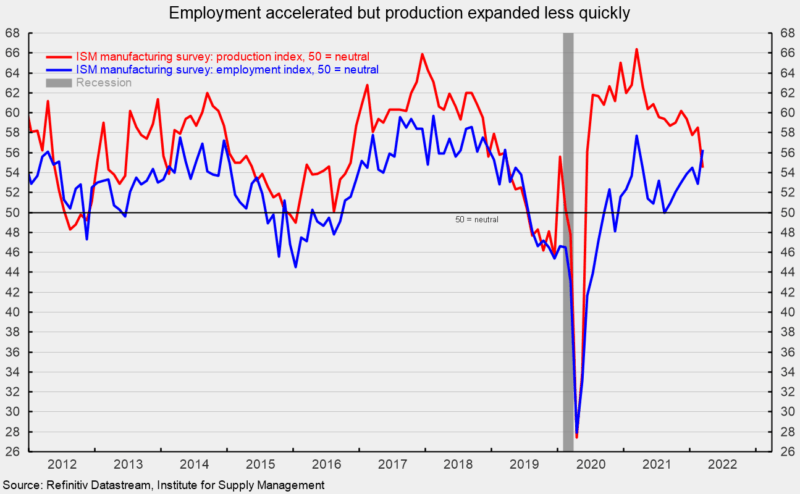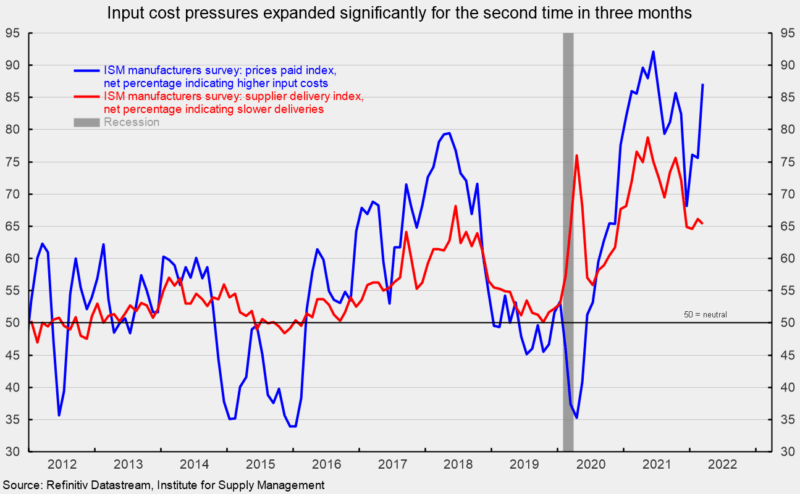Manufacturing-Sector Survey Suggests Slower Expansion but Increased Price Pressures in March
The Institute for Supply Management’s Manufacturing Purchasing Managers’ Index fell to 57.1 in March, off 1.5 points from 58.6 percent in February (50 is neutral). March is the 22nd consecutive reading above the neutral threshold but the level continues to trend lower from the March 2021 peak (see top of first chart). The survey results indicate that the manufacturing sector continues to expand but price pressures worsened. The report also suggests labor shortages from quits and retirements remain a significant headwind though perhaps slightly less than last month. Overall, survey respondents remain optimistic about future demand.
The new orders index fell sharply, losing 7.9 points to 53.8 percent in March. It has been above 50 for 22 consecutive months but is at the lowest level since the post-lockdown plunge (see bottom of first chart). The new export orders index, a separate measure from new orders, fell to 53.2 versus 57.1 in February. The new export orders index has been above 50 for 21 consecutive months. The Backlog-of-Orders Index came in at 60.0 versus 65.0 in February, a 5-point decline (see bottom of first chart). This measure has pulled back from the record-high 70.6 result in May 2021 but has been above 50 for 21 consecutive months. The index suggests manufacturers’ backlogs continue to rise but that the pace decelerated in March.
The Production Index registered a 54.5 percent result in March, a drop of 4.0 points from February. The index has been above 50 for 22 months but is at its lowest level since the plunge in early 2020 (see second chart).
The Employment Index showed a solid gain in March holding above neutral for the seventh consecutive month and sixteenth consecutive reading at or above the neutral 50 level, coming in at 56.3 percent (see second chart). The run of results at or above neutral is an indication that some of the labor issues plaguing production may start to ease in coming months. The Bureau of Labor Statistics’ Employment Situation report for March showed a gain of 431,000 nonfarm payroll jobs including the addition of 38,000 jobs in manufacturing.
Customer inventories in March are still considered too low, with the index coming in at 34.1, up 2.3 points from February (index results below 50 indicate customers’ inventories are too low). The index has been below 50 for 66 consecutive months. Insufficient inventory is a positive sign for future production.
The index for prices for input materials jumped in March, up 11.5 points to 87.1 percent versus 75.6 percent in February (see third chart). The index is moving back towards the recent peak of 92.1 in June 2021 and suggests price pressures are reaccelerating. Meanwhile, the supplier deliveries index registered a 65.4 result in March, down 0.7 points from the February result. The rise suggests deliveries slowed again in March and that the pace decelerated slightly.
Demand for the manufacturing sector expanded again but the breadth of expansion has narrowed, suggesting a slower pace. Labor difficulties, materials shortages, and logistical problems continue to hamper the ability to meet that demand. While there has been some modest progress, the period of normalization has been extended by recurring waves of Covid, labor turnover, and worker retirement. The delayed return to normalcy is sustaining upward pressure on prices. Recent events in Ukraine may be yet another source of disruption and further delay the return to normalcy.








